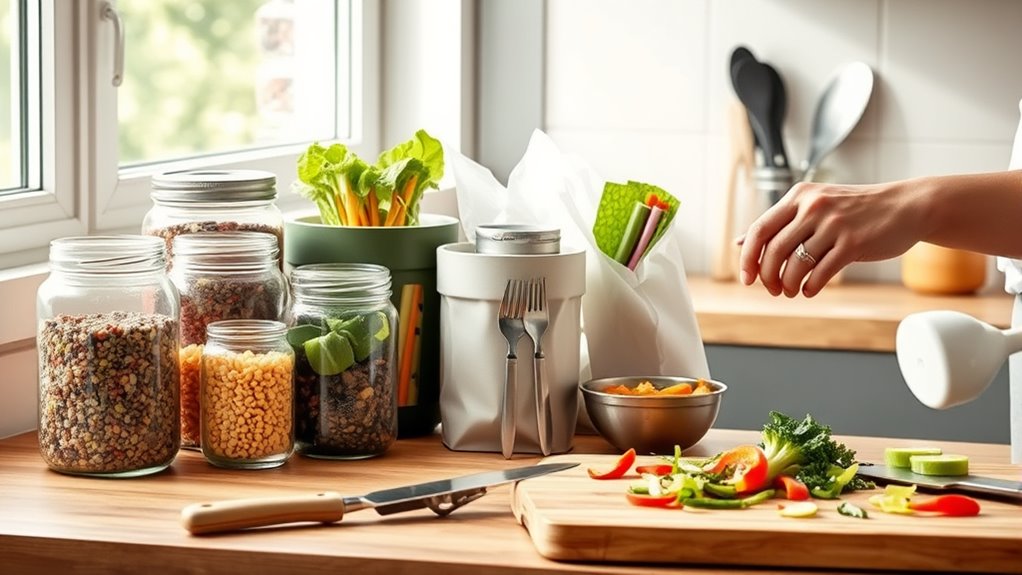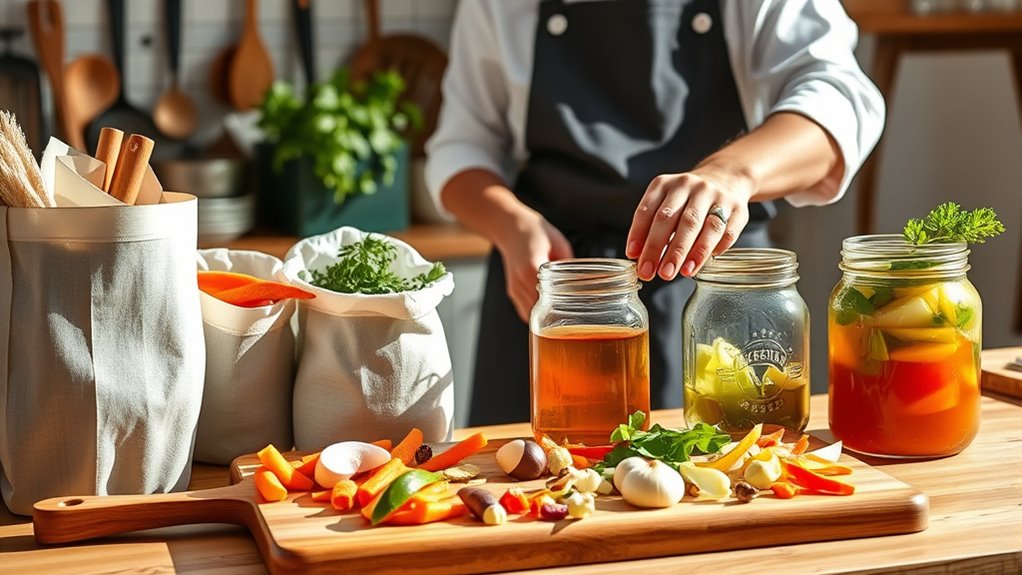To practice zero-waste cooking, focus on maximizing ingredient use through proper preservation techniques like freezing, pickling, and dehydrating. Save scraps for composting to enrich your garden and reduce landfill waste. Plan meals carefully to avoid excess, and get creative with overripe fruits or wilted greens. These simple yet effective habits help you reduce environmental impact, save money, and foster sustainable habits in your kitchen—discover more ways to make your cooking eco-friendly as you explore further.
Key Takeaways
- Utilize ingredient preservation techniques like freezing, pickling, and dehydration to extend shelf life and reduce waste.
- Incorporate food scraps into composting to create nutrient-rich soil and minimize landfill waste.
- Plan meals carefully and buy in bulk with proper portions to prevent excess spoilage and impulsive purchases.
- Transform overripe fruits and wilted greens into jams, smoothies, or cooked dishes to avoid disposal.
- Promote sustainable practices by reducing food waste, supporting local compost programs, and fostering culinary creativity.

Many people are discovering that zero-waste cooking isn’t just good for the environment—it can also save you money and inspire more creative meals. One of the key aspects of this approach is ingredient preservation. When you learn to properly store and preserve your ingredients, you reduce spoilage and waste. For example, instead of tossing out slightly wilted greens, you can revive them with a quick blanch and freeze, or turn overripe fruits into jams or smoothies. Preserving ingredients extends their lifespan, making sure you get the most out of every item you buy. It also encourages you to plan ahead, buying in bulk and portioning correctly to avoid excess that might go bad before use. Techniques like dehydration, pickling, and freezing are simple yet effective ways to keep ingredients fresh longer, helping you minimize waste and stretch your grocery budget.
Another essential element in zero-waste cooking is composting techniques. Composting allows you to turn food scraps and organic waste into nutrient-rich soil, closing the loop in your kitchen’s lifecycle. You can start small by composting vegetable peels, coffee grounds, eggshells, and paper towels in a designated bin. If you don’t have outdoor space, there are countertop composters that work indoors, converting scraps into compost with minimal odor. Using composting techniques means you’re not sending food waste to landfills, where it produces methane, a potent greenhouse gas. Instead, you’re giving those scraps a second life by enriching your garden soil or supporting local community compost programs. Incorporating composting into your routine is straightforward once you establish a system and learn the basics, like balancing green and brown materials and maintaining airflow. Additionally, ingredient preservation plays a crucial role in reducing overall waste, by maximizing the use of every ingredient you purchase and prepare. Doing so not only reduces your environmental footprint but also fosters a deeper connection with your food and its journey from farm to table.
Frequently Asked Questions
How Can I Start Practicing Zero-Waste Cooking at Home?
To start practicing zero-waste cooking at home, focus on meal planning to minimize leftovers and avoid waste. Use leftovers creatively for new meals, and prioritize ingredient preservation techniques like freezing, canning, or drying to extend shelf life. Shop mindfully by buying only what you need, and choose eco-friendly packaging. These steps help you reduce waste, save money, and enjoy fresh, delicious meals every day.
What Are Common Mistakes to Avoid in Zero-Waste Cooking?
Avoid common mistakes like neglecting food waste reduction strategies, which can lead to unnecessary waste. For example, skipping composting techniques means valuable scraps end up in the landfill. Always plan meals carefully, store leftovers properly, and compost organic waste. Don’t forget to regularly monitor your compost to guarantee it breaks down efficiently. These practices help you minimize waste, save money, and support a sustainable kitchen.
Are Zero-Waste Cooking Techniques Suitable for Large-Scale Restaurants?
Yes, zero-waste cooking techniques can work in large-scale restaurants. You need to adapt strategies to your commercial kitchen setup, focusing on efficient use of ingredients and minimizing waste. Managing your supply chain carefully is essential to guarantee quality and reduce excess. Implementing composting, repurposing leftovers, and training staff helps maintain sustainability at scale, making zero-waste practices both practical and beneficial for your restaurant’s environmental impact.
How Do I Store Leftovers to Minimize Waste Effectively?
You should store leftovers in airtight containers to prevent spoilage and extend freshness. Use glass or stainless steel containers for better food preservation, as they don’t stain or retain odors. Label each container with dates to track freshness and avoid waste. Keep leftovers in the fridge or freezer depending on how soon you’ll consume them. Proper storage reduces waste and helps you practice sustainable culinary habits.
What Tools or Equipment Are Essential for Zero-Waste Cooking?
Think of it as building a sustainable kitchen fortress. You’ll need reusable containers to store leftovers and ingredients, reducing single-use plastics. Compost bins are essential for turning food scraps into nutrient-rich soil, closing the waste loop. A sharp knife, cutting boards, and jars further support your zero-waste journey. These tools help you minimize waste, stay organized, and embrace eco-friendly cooking habits, making your kitchen a true model of sustainability.
Conclusion
By adopting zero-waste cooking, you can make a real difference—reducing food waste by up to 30% and helping the environment. Every small change, like repurposing leftovers or using vegetable scraps, adds up to a more sustainable future. Remember, your efforts not only save resources but also inspire others to follow suit. Together, we can create a greener planet—one meal at a time. Start small, stay committed, and enjoy the positive impact you make.









